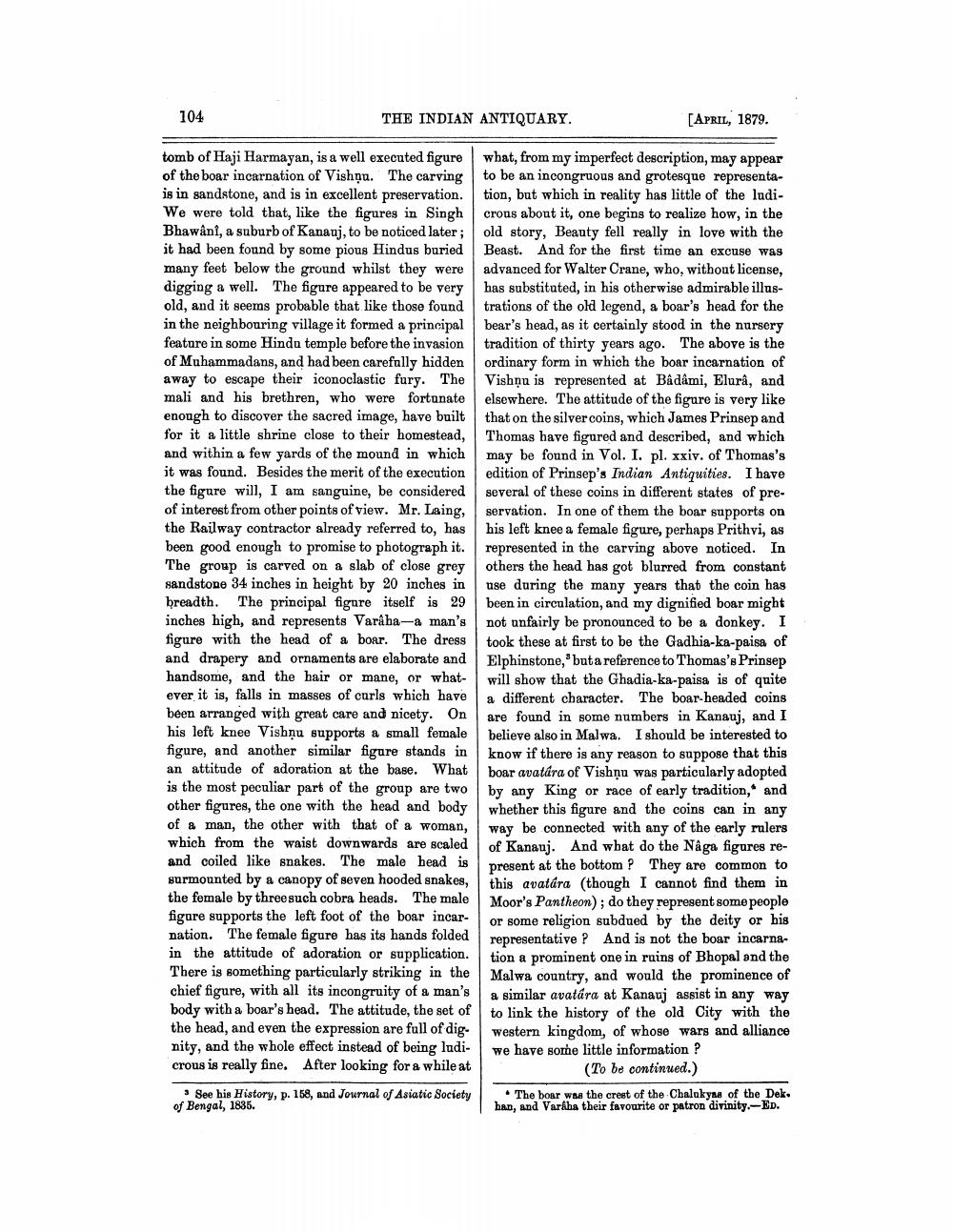________________
104
THE INDIAN ANTIQUARY.
tomb of Haji Harmayan, is a well executed figure of the boar incarnation of Vishnu. The carving is in sandstone, and is in excellent preservation. We were told that, like the figures in Singh Bhawani, a suburb of Kanauj, to be noticed later; it had been found by some pious Hindus buried many feet below the ground whilst they were digging a well. The figure appeared to be very old, and it seems probable that like those found in the neighbouring village it formed a principal feature in some Hindu temple before the invasion of Muhammadans, and had been carefully hidden away to escape their iconoclastic fury. The mali and his brethren, who were fortunate enough to discover the sacred image, have built for it a little shrine close to their homestead, and within a few yards of the mound in which it was found. Besides the merit of the execution the figure will, I am sanguine, be considered of interest from other points of view. Mr. Laing, the Railway contractor already referred to, has been good enough to promise to photograph it. The group is carved on a slab of close grey sandstone 34 inches in height by 20 inches in breadth. The principal figure itself is 29 inches high, and represents Varaha-a man's figure with the head of a boar. The dress and drapery and ornaments are elaborate and handsome, and the hair or mane, or whatever it is, falls in masses of curls which have been arranged with great care and nicety. On his left knee Vishnu supports a small female figure, and another similar figure stands in an attitude of adoration at the base. What is the most peculiar part of the group are two other figures, the one with the head and body of a man, the other with that of a woman, which from the waist downwards are scaled and coiled like snakes. The male head is surmounted by a canopy of seven hooded snakes, the female by three such cobra heads. The male figure supports the left foot of the boar incarnation. The female figure has its hands folded in the attitude of adoration or supplication. There is something particularly striking in the chief figure, with all its incongruity of a man's body with a boar's head. The attitude, the set of the head, and even the expression are full of dig. nity, and the whole effect instead of being ludicrous is really fine. After looking for a while at
See his History, p. 158, and Journal of Asiatic Society of Bengal, 1835.
[APRIL, 1879.
what, from my imperfect description, may appear to be an incongruous and grotesque representation, but which in reality has little of the ludicrous about it, one begins to realize how, in the old story, Beauty fell really in love with the Beast. And for the first time an excuse was advanced for Walter Crane, who, without license, has substituted, in his otherwise admirable illustrations of the old legend, a boar's head for the bear's head, as it certainly stood in the nursery tradition of thirty years ago. The above is the ordinary form in which the boar incarnation of Vishnu is represented at Bâdâmi, Elurâ, and elsewhere. The attitude of the figure is very like that on the silver coins, which James Prinsep and Thomas have figured and described, and which may be found in Vol. I. pl. xxiv. of Thomas's edition of Prinsep's Indian Antiquities. I have several of these coins in different states of preservation. In one of them the boar supports on his left knee a female figure, perhaps Prithvi, as represented in the carving above noticed. In others the head has got blurred from constant use during the many years that the coin has been in circulation, and my dignified boar might not unfairly be pronounced to be a donkey. I took these at first to be the Gadhia-ka-paisa of Elphinstone," but a reference to Thomas's Prinsep will show that the Ghadia-ka-paisa is of quite a different character. The boar-headed coins are found in some numbers in Kanauj, and I believe also in Malwa. I should be interested to know if there is any reason to suppose that this boar avatára of Vishnu was particularly adopted by any King or race of early tradition, and whether this figure and the coins can in any way be connected with any of the early rulers of Kanauj. And what do the Nâga figures represent at the bottom? They are common to this avatára (though I cannot find them in Moor's Pantheon); do they represent some people or some religion subdued by the deity or his representative? And is not the boar incarna tion a prominent one in ruins of Bhopal and the Malwa country, and would the prominence of a similar avatára at Kanauj assist in any way to link the history of the old City with the western kingdom, of whose wars and alliance we have some little information ?
(To be continued.)
The boar was the crest of the Chalukyas of the Dek han, and Varáha their favourite or patron divinity.-ED.




